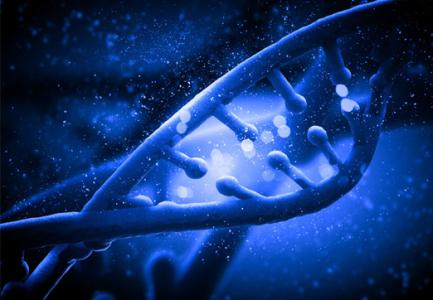科技
Molecular Biology: Folding Stuff
分子生物學(xué):折疊
Shape determines a protein's function. Determining that shape, though, is tricky.
蛋白質(zhì)的結(jié)構(gòu)決定功能,而結(jié)構(gòu)的形成卻很難。
ABOUT 120,000 types of protein molecule have yielded up their structures to science.
科學(xué)家已經(jīng)了解了大約有120000種蛋白質(zhì)分子的結(jié)構(gòu)。
That sounds a lot, but it isn’t.
這看起來(lái)有很多,實(shí)則不然。

The techniques, such as X-ray crystallography and nuclear-magnetic resonance (NMR), which are used to elucidate such structures do not work on all proteins.
像X-射線晶體學(xué),核磁共振(NMR)等一些用于分析蛋白質(zhì)結(jié)構(gòu)的技術(shù),并非在所有蛋白質(zhì)上都適用。
Some types are hard to produce or purify in the volumes required.
有些種類的蛋白質(zhì)很難生產(chǎn)的或難以提純出所需要的量。
Others do not seem to crystallise at all—a prerequisite for probing them with X-rays.
其他類型的則無(wú)法結(jié)晶化——而這是利用X-ray檢測(cè)結(jié)構(gòu)的先決條件。
As a consequence, those structures that have been determined include representatives of less than a third of the 16,000 known protein families.
這就導(dǎo)致,在16000個(gè)已知蛋白質(zhì)家族的代表中,只有不超過(guò)三分之一的蛋白質(zhì)的結(jié)構(gòu)是已知的。
Researchers can build reasonable computer models for around another third, because the structures of these resemble ones already known.
基于已知曉的蛋白質(zhì)的結(jié)構(gòu),研究人員可以針對(duì)另外1/3的蛋白質(zhì)建立合理的計(jì)算機(jī)模型。
For the remainder, however, there is nothing to go on.
然而對(duì)剩余的部分卻束手無(wú)策。
In addition to this lack of information about protein families, there is a lack of information about those from the species of most interest to researchers: Homo sapiens.
除蛋白質(zhì)家族的信息缺乏外,研究者對(duì)最讓他們感興趣的物種“智人”體內(nèi)的蛋白質(zhì)的了解也不多。
Only a quarter of known protein structures are human.
已知結(jié)構(gòu)的蛋白質(zhì)中,有1/4屬于人體內(nèi)的蛋白質(zhì)。
A majority of the rest come from bacteria.
其余大部分來(lái)自于細(xì)菌。
This paucity is a problem, for in proteins form and function are intimately related.
因蛋白質(zhì)的形態(tài)和功能密切相關(guān),這一信息的缺失是個(gè)問(wèn)題。
A protein is a chain of smaller molecules, called amino acids, that is often hundreds or thousands of links long.
一個(gè)蛋白質(zhì)分子是由較小分子所組成的分子鏈,稱之為氨基酸,蛋白質(zhì)通常有成百上千條相鏈接。
By a process not well understood, this chain folds up, after it has been made, into a specific and complex three-dimensional shape.
通過(guò)一個(gè)尚未明確的加工過(guò)程,分子鏈生成會(huì)后折疊成特定復(fù)雜的三維結(jié)構(gòu)。
That shape determines what the protein does: acting as a channel, say, to admit a chemical into a cell; or as an enzyme to accelerate a chemical reaction; or as a receptor, to receive chemical signals and pass them on to a cell’s molecular machinery.
蛋白質(zhì)的結(jié)構(gòu)決定了他們的工作角色,充當(dāng)通道,讓化學(xué)物質(zhì)進(jìn)入細(xì)胞,或者作為一種加速化學(xué)反應(yīng)速度的酶;又或是作為受體接收化學(xué)信號(hào)并將其傳遞到細(xì)胞的分子機(jī)制內(nèi)。
Almost all drugs work by binding to a particular protein in a particular place, thereby altering or disabling that protein’s function.
幾乎所有的藥物都通過(guò)與特定位置的特定蛋白質(zhì)相結(jié)合而發(fā)揮作用,從而改變或限制蛋白質(zhì)的功能。
Designing new drugs is easier if binding sites can be identified in advance.
如果可以預(yù)先得知靶位點(diǎn),研發(fā)新藥物就較容易了。
But that means knowing the protein’s structure.
但這意味著要知道蛋白質(zhì)的結(jié)構(gòu)。
To be able to predict this from the order of the amino acids in the chain would thus be of enormous value.
利用氨基酸在分子鏈中的順序,預(yù)測(cè)出蛋白質(zhì)的結(jié)構(gòu)是有著極為重大意義的。
That is a hard task, but it is starting to be cracked.
這是一項(xiàng)艱巨的任務(wù),但現(xiàn)在已經(jīng)有了一定進(jìn)展。



